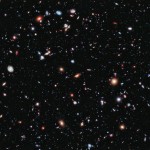Something like 50 years ago, two astronomers made a discovery by accident, which became central to the current leading theory of the creation of the universe – and the theory which the most cosmologists consider to be essentially correct: The Big Bang.
At Bell Laboratories in New Jersey, USA, Arno Penzias and Robert Woodrow Wilson had built an antenna that they intended to use in satellite communication experiments. But they were disturbed by a background signal which the antenna detected no matter in which direction it was pointed.
The astronomers scrutinised their design to find out what caused the ”error”. First, they discovered a family of pigeons living in the antenna. The pigeons and their droppings were removed, but the mysterious background signal remained.
At the same time, a group of scientists from Princeton University in the US were building a similar antenna. The Princeton scientists had realised that if the Big Bang had happened, there had to be radiation left in the universe dating back from the time shortly after, which could still be detected. And proponents of the Big Bang theory needed something measurable that could be shown and pointed to as a direct consequence of the Big Bang. Something that astronomers could use to show that the basic elements of the theory were correct.
When Penzias and Wilson heard of the search for the suspected radiation, they called the Princeton scientists, and told them about the “error signal” they had detected. After a meeting between the two groups of astronomers, it was established that Penzias and Wilson had detected what is now known as cosmic background radiation.
Big Bang? BIG CRAZY!
Today, the Big Bang theory is generally accepted, and it is also accepted that 14 billion years ago, the entire universe was united in one point, from which it suddenly began to expand. But when the idea was introduced for the first time, it sounded completely absurd to many people. Most of them had grown up with the idea of a never-ending, constant universe, making it difficult for them to imagine a universe with a beginning.
Even in the early 1900s, scientific theories concerning an inconstant universe existed. In 1916, Albert Einstein published his general relativity theory, which predicted that the universe was either expanding or contracting. If the theory was correct, the universe could not be static. But Einstein was so convinced that the universe was static that the theory had to be incorrect, even according to himself. He added an extra constant to the equations, so the universe could be static without it being in conflict with his new theory.
In the same decade, astronomers Vesto Slipher and Carl Wilhelm Wirtz observed that most “spiral nebulae” were moving away from Earth. Today, we know that the spiral nebulae are really remote galaxies, and that their motion away from us is a consequence of the universe expanding. But Slipher and Wirtz did not know that the spiral nebulae were located outside our own galaxy, and they did not understand what they saw.
A Belgian astronomer with an unusual idea
In 1927, Belgian astronomer and physicist Georges Lemaître suggested that the universe is expanding. Lemaître noted that not all Slipher and Wirtz’ “spiral nebulae” were moving away from Earth at the same pace. The further away they were, the faster they moved. But existing observations were not sufficiently accurate to prove his theory, and many physicists, including Einstein, rejected his theory as a purely mathematical model, which had no grounding in reality. But two years later, in 1929, American astronomer Edwin Hubble made the observations that Lemaître needed. Hubble’s observations showed that the speed at which a galaxy moves away from us is directly proportional to its distance from Earth. The further away a galaxy is, the faster it moves away from us. As soon as Hubble had published his results, Einstein changed his relativity theory back to the original, describing “Einstein’s Constant” as the greatest mistake of his life.
The 35 years’ war
Hubble’s observations kicked off a 35-year duel between two different ways of interpreting the observations. In 1931, Lemaître introduced a theory saying that the universe had begun in an “ancient atomic blast”, from which it was now expanding, and that all matter in the universe had been created in the explosion. Back then, most cosmologists were still convinced that the universe was static, never-ending, and constant, and they did not accept Lemaître’s model, in which time and space had a clear beginning. According to them, Lemaître was mixing religion and science. They had a point: apart from being an astronomer, Lemaître was also a Roman Catholic priest.
English astronomer Fred Hoyle was one of the opponents of Lemaître’s model, and in 1948, he introduced a model of the universe, according to which new matter had been created as the galaxies moved away from each other. The average density of the universe remained constant, and the universe was constant, though it expanded. The theory was named the “Steady State theory”. In a BBC radio broadcast in 1949, Fred Hoyle sarcastically called Lemaître’s theory “the Big Bang idea”. Yes, the name of science’s leading theory for the beginning of the universe itself was originally meant to be a cruel joke.
Einstein’s constant returns AGAIN!
The discovery of cosmic background radiation in 1964 killed off the Steady State theory once and for all, and today, almost all cosmological scientific work is based on the Big Bang – or something very like it – being the fundamental model for the beginning of the universe. But that does not necessarily mean that cosmologists have solved all mysteries concerning the universe.
In 1998, a group of US astronomers’ observations of remote supernovas demonstrated that the universe is not just expanding – the rate of expansion is accelerating. The existing Big Bang theory cannot explain this, and it does not immediately fit into Einstein’s general relativity theory.
The accelerating expansion is one of the mysteries of our time concerning the universe. Ironically, cosmologists wonder if Einstein was somehow right anyway when he added an extra constant to his equations. Still, the constant which they are thinking about adding is not one that fits into a static universe, but one that fits into a universe that is expanding ever faster.









